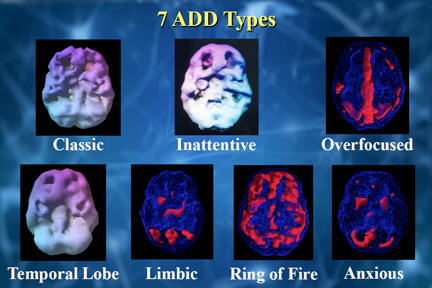7 Types of ADD (Attention Deficit Disorder)


Attention Deficit Disorder is one of the most well-recognized childhood developmental problems.
But it doesn’t end in childhood. Did you know that a full 60% of those diagnosed with ADD in childhood will continue to have issues that affect their functioning as adults? It’s true. And ADD can fly under the radar in adults who were never diagnosed in childhood.
While prevalence rates are not entirely clear for adults, as mentioned earlier, they are estimated to fall within the 4% to 5% range.
That’s a lot of adults struggling with attention problems! What’s more, ADD remains one of the most misunderstood and incorrectly treated illnesses today.
But that is changing.
Using breakthrough diagnostic techniques, Dr. Amen has discovered that there are 7 distinct types of ADD, each requiring a different treatment.
This is good news because more people can be helped with treatments that are tailored to their specific ADD type.
But the first step in healing from ADD is to determine if you have it.
Here are several identifying behaviors to look for – and the 7 types of ADD revealed:
There are five longstanding hallmark symptoms of ADD:
- Short attention span. People with ADD have a difficult time with boring tasks (such as regular, routine, everyday tasks) and need stimulation or excitement in order to stay engaged. Many people with ADD can pay attention just fine for things that are new, novel, interesting, highly stimulating, or frightening.
- Distractibility. People with ADD tend to notice more in their environment than others, which makes them easily distracted by outside stimuli, such as light, sounds smells, certain tastes or even the clothes they wear. Their keen sensitivity causes them to get easily off task.
- Disorganization. Most people with ADD tend to struggle with organization of time and space. They tend to be late and have trouble completing tasks on time. Many things get done at the last moment or even later. They also tend to struggle keeping their spaces tidy, especially their rooms, book bags, filing cabinets, drawers, closets and paperwork.
- Procrastination. Tasks and duties get put off until the last moment. Things tend not to get done until there are deadlines or someone else is mad at them for not doing it.
- Poor internal supervision. Many people with ADD have issues with judgment and impulse control and struggle not to say or do things without fully thinking it through. They also have a harder time learning from their mistakes.
You need at least three of these symptoms over a long period of time, and these symptoms, in some way, should interfere with your life.
Here’s a brief description of each type:
Type 1. Classic ADD (ADHD) – inattentive, distractible, disorganized, hyperactive, restless, and impulsive.
Type 2. Inattentive ADD – inattentive, easily distracted, disorganized, and often described as space cadets, daydreamers, and couch potatoes. Not hyperactive!
Type 3. Overfocused ADD – inattentive, trouble shifting attention, frequently get stuck in loops of negative thoughts or behaviors, obsessive, excessive worrying, inflexible, frequent oppositional and argumentative behavior. May or may not be hyperactive.
Type 4. Temporal Lobe ADD – inattentive, easily distracted, disorganized, irritable, short fuse, dark thoughts, mood instability, and may struggle with learning disabilities. May or may not be hyperactive.
Type 5. Limbic ADD – inattentive, easily distracted, disorganized, chronic low grade sadness or negativity, “glass half empty syndrome,” low energy, tends to be more isolated socially, and frequent feelings of hopelessness and worthlessness. May or may not be hyperactive.
Type 6. Ring of Fire ADD – inattentive, easily distracted, irritable, overly sensitive, cyclic moodiness, and oppositional. May or may not be hyperactive.
Type 7. Anxious ADD – inattentive, easily distracted, disorganized, anxious, tense, nervous, predicts the worst, gets anxious with timed tests, social anxiety, and often has physical stress symptoms, such as headaches, and gastrointestinal symptoms. May or may not be hyperactive.
If you think that you or a loved one may have ADD, take our new online questionnaire to learn more.

